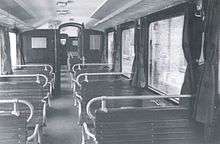BDŽ class 81 01-03
The vehicles of the BDŽ class 05 01-03 (later class 81 01-03) were four-axle Diesel–mechanical railcars designed for the 760 mm narrow-gauge railways of the Bulgarian State Railways (BDŽ).
| BDŽ class 05 01–03 BDŽ class 81 01-03 | |
|---|---|
| Number(s) | BDŽ: 05 01–03 BDŽ: 81 01–03 |
| Quantity | 3 |
| Manufacturer | Ganz Works, Budapest |
| Year(s) of manufacture | 1941 |
| Retired | 1975 |
| Axle arrangement | B'B' |
| Track gauge | 760 mm (2 ft 5 15⁄16 in) Bosnian gauge |
| Length over buffers | 17,000 mm (55 ft 9 in) |
| Pivot pitch | 11,900 mm (39 ft 1 in) |
| Bogie wheelbase | 1,700 mm (5 ft 7 in) |
| Overall wheelbase | 13,600 mm (44 ft 7 in) |
| Minimum curve | 60 m (200 ft) |
| Empty weight | 25 t (25 long tons; 28 short tons) |
| Service weight | 31.4 t (30.9 long tons; 34.6 short tons) |
| Adhesive weight | 31.4 t (30.9 long tons; 34.6 short tons) |
| Axle load | 8 t (7.9 long tons; 8.8 short tons) |
| Top speed | 60 km/h (37 mph) |
| Installed power | 162 kW (220 PS) |
| Starting tractive effort | 40 kN (9,000 lbf) |
| Wheel diameter | 720 mm (2 ft 4 in) |
| Motor make/model | Ganz Works VI IaT 170/240 |
| Motor type | Six cylinder four-stroke Diesel engine |
| Power transmission | Diesel–mechanical |
| Tank capacity | 335 l (74 imp gal; 88 US gal) |
| Brakes | Knorr-Bremse compressed air brake hand brake |
| Seats | 6/35 |
| Coach class | 2./3. |
History
Since there were many tunnels on the Rhodope Railway, there was naturally also a great deal of annoyance on the part of the staff and passengers traveling uphill through the exhaust fumes of the locomotives. Therefore, the BDŽ decided already in the year of the opening in 1939 to procure diesel railcars for comfort improvement.
1941 followed then the delivery of three motor coaches and three additional trailers with a seat capacity of 62 seats. Seven similar railcars had been delivered in 1938 to the Yugoslav Railways for the local narrow gauge network as a series 801. The railcars were used only on the Rhodope Railway. In 1952, four more railcars of BDŽ class 05 04-07 were ordered with increased power. Earliest timetables for the vehicles are known only from the year 1969, where the first railcar now designated as 81-01 covered the connection between Varvara and Pazardzhik six times daily.[1] Much earlier, in 1963, the railcar 81-03 had already been retired.[2] After the appearance of the new class 75, the vehicles were not resettled together with the class 82 to Cherven Bryag, but they remained in Septemvri. The withdrawal took place in 1973 (81-01) and 1975 (81-02). Another sign of life is not to be found for the vehicles. They were stationed until their cancellation in Septemvri, the subject of the photo created in 2015 could come from the pre-war production.[3]
At their delivery, the vehicles had a very modern silver-gray paint. Later, some vehicles were painted blue in the lower half and white in the upper half. Whether vehicles of this series, is not known, all known photos with vehicles of the series 81 have a silver-gray paint.
Technical features

The vehicles were optimally designed for the conditions of the Rhodopebahn as mountain railcars with the highest friction weight (identical to the service mass). For narrow-gauge conditions they were designed quite large, much larger than the known narrow-gauge railcars DR 137 322 to 325, which they still towered by three meters in length. But they had about the same number of seats as this series.
In one end of the steel skeleton construction of the car body were placed the seats in wood lath construction and in the other end the machinery. Where the diesel engine was located, there was a luggage and payload compartment. The cargo compartment was closed with a central folding door, the entrances for the passengers were via the doors close to the end of the railcar. The entry spaces were the workplaces for the engine driver, on the end not used the controls could be closed by roller blinds.[4] The trailers were similarly designed, they lacked the payload compartments and the center doors. But they had a significantly higher capacity with 62 seats.
About the machinery it is known that the engine was Ganz VI IaT 170/240 that produced 220 hp (160 kW) and the power transmission was mechanical. The engine gave its torque to the four-speed transmission lying exactly in the middle of the car, both bogie wheels were driven by Cardan shafts. This arrangement gave the railcar an extraordinarily high frictional weight, enabling it to handle any situation on the mountain railway.
Sources
Translated from BDŽ-Baureihe 05 01–03
References
- Paul Engelbert: Schmalspurig durch Bulgarien, Stenvalls Verlag, Malmö 2002, ISBN 91-7266-155-0, page 71
- Paul Engelbert: Schmalspurig durch Bulgarien, Stenvalls Verlag, Malmö 2002, ISBN 91-7266-155-0, page 93
- Photo of the wreck of a trailer of a Ganz railcar in Septemvri
- Draft with photos of railcar class 82